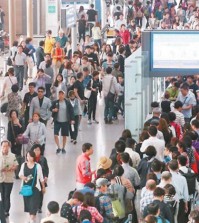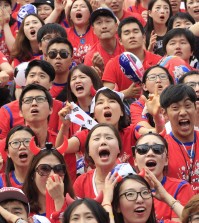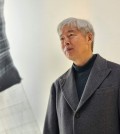- California Assembly OKs highest minimum wage in nation
- S. Korea unveils first graphic cigarette warnings
- US joins with South Korea, Japan in bid to deter North Korea
- LPGA golfer Chun In-gee finally back in action
- S. Korea won’t be top seed in final World Cup qualification round
- US men’s soccer misses 2nd straight Olympics
- US back on track in qualifying with 4-0 win over Guatemala
- High-intensity workout injuries spawn cottage industry
- CDC expands range of Zika mosquitoes into parts of Northeast
- Who knew? ‘The Walking Dead’ is helping families connect
People over 65 make up 12.7 pct of S. Korea’s population

Senior citizens stand in long lines to submit their resumes during a job fair for the elderly in Chungju, North Chungcheong Province, on Feb. 25, 2015. (Photo courtesy of Chungju City Hall) (Yonhap)
SEJONG, March 19 (Yonhap) — The proportion of the population over 65 moved up 0.5 percentage point to 12.7 percent in 2014 from a year ago, data showed Thursday, a clear sign that South Korea is aging at a fast pace.
According to data by Statistics Korea, the rise in the percentage of senior citizens corresponds to the dip in the number of newborn babies and backtracking of the natural rate of population increase.
There were over 436,000 newborns last year, down 1,000 from a year before, while deaths hit 266,000 up 2,000 from 2013, with the total population standing at 50.42 million.
The rate of natural population increase, which is the crude birth rate minus the crude death rate, stood at 3.3 percent for 1,000 people, down from 3.4 in 2013.
The population of people over 65 has been growing consistently for decades, rising from just 3.8 percent in 1980 to 7.2 percent in 2000 and 11 percent in 2010. In contrast, young people under 14, whose numbers are directly tied to births, made up 14.3 percent of the total population in 2014 from 14.7 percent the year before and 21.1 percent in 2000.
The statistical office said at the current pace, the percentage of senior citizens will rise to 24.3 percent in 2030 and 32.3 percent a decade later.
The figures come amid growing fears that South Korea is fast approaching the “aged society” boundary in which more than 14 percent of the population is 65 or older.
The government expects the country will become a super-aged society around 2026 when at least 20 percent of the people will be over 65. South Korea became an “aging society” in 2000, when the ratio topped 7 percent.
Experts have expressed concerns that the aging population, coupled with low birth rates, poses a serious threat to the nation’s economy as it could lead to fewer working people and increased spending on health and welfare.
The latest data then showed that every 100 working-age people supported the livelihoods of 17.3 senior citizens last year, with this number expected to triple to 100 people providing for 57.2 senior citizens in 2040.
Affected by falling birth rates, the country’s population will peak at about 52.16 million in 2030 before dropping to 51.09 million by 2040, the agency forecast.
The statistical office said the number of people tying the knot fell 1.3 percent to 323,000 last year, with those getting a divorce standing at 114,000, or a rise of 0.9 percent.
The percentage of economically active people rose 0.9 percentage point on-year to 62.4 percent, with numbers going up for both men and women.
The employment rate stood at 60.2 percent for last year, a gain of 0.7 percentage point vis-a-vis 2013.
The findings also showed South Koreans are growing more health conscious.
The proportion of smokers among people aged 19 or older declined to 23.2 percent in 2013 from 25 percent in 2012. People who are classified as excessive drinkers dipped 1.8 percentage points to 15.9 percent in 2013, with percentage of the population viewed as being overweight falling to 32.9 percent from 32.8 percent in the same time period.
The data showed that cancer was the No. 1 cause of death in 2013, with 149 per 100,000 people losing their lives to the disease. Cerebrovascular and cardiovascular diseases came in second and third in terms of death rates, the data showed.















